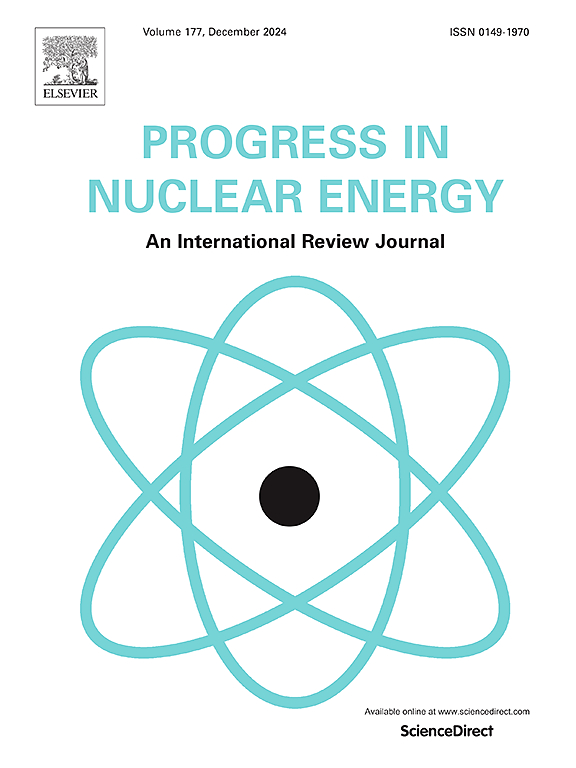Comprehensive analysis of oxygen mass transfer and impurity dynamics in oxygen-controlled ELSY lead-cooled reactors
IF 3.3
3区 工程技术
Q1 NUCLEAR SCIENCE & TECHNOLOGY
引用次数: 0
Abstract
In lead-cooled fast reactors, precise oxygen control is critical for mitigating corrosion, maintaining protective oxide layers, enhancing heat transfer, and reducing impurity deposition. However, achieving consistent oxygen management is challenging due to the high cost and limited availability of sensitive sensors, along with difficulties in monitoring oxygen distribution in pool-type reactors. Existing studies often oversimplify oxygen dynamics, neglecting the impacts of temperature gradients and cyclic flows on reactor-wide oxygen behavior and corrosion processes. This study refines traditional models by incorporating corrosion mechanisms and experimental data to analyze oxygen interactions with iron oxide nucleation in oxygen-controlled environments. Using Computational Fluid Dynamics (CFD), the distribution of oxygen and corrosion products is examined under various conditions. Results reveal hypoxic zones in high-flow and reflux regions under anoxic conditions, with inlet oxygen concentrations reaching a minimum at 1715 s. Enhanced gas-phase mass transfer stabilizes oxygen levels, reducing iron release and ensuring uniform distribution over time. Impurity nucleation begins in the cold zone beneath the steam generator at 7960 s, highlighting critical areas for management. By coupling reactor-wide oxygen dynamics and impurity behavior, this study underscores the importance of optimized oxygen management to mitigate corrosion, control impurities, and ensure long-term reactor stability, safety, and efficiency.
氧控ELSY铅冷堆中氧传质和杂质动力学的综合分析
在铅冷快堆中,精确的氧气控制对于减轻腐蚀,保持氧化层保护,增强传热和减少杂质沉积至关重要。然而,由于高成本和敏感传感器的有限可用性,以及监测池式反应器中氧气分布的困难,实现一致的氧气管理是具有挑战性的。现有的研究往往过于简化氧动力学,忽略了温度梯度和循环流动对全反应器氧行为和腐蚀过程的影响。本研究通过结合腐蚀机制和实验数据来改进传统模型,以分析氧控制环境中氧与氧化铁成核的相互作用。利用计算流体动力学(CFD)对不同条件下氧和腐蚀产物的分布进行了研究。结果显示,在缺氧条件下,高流量和回流区域存在缺氧区,入口氧浓度在1715s达到最低。增强气相传质稳定氧水平,减少铁释放,并确保均匀分布随着时间的推移。杂质成核开始于蒸汽发生器下方的冷区,温度为7960 s,突出了需要管理的关键区域。通过耦合整个反应器的氧动力学和杂质行为,本研究强调了优化氧管理的重要性,以减轻腐蚀,控制杂质,并确保反应器的长期稳定性,安全性和效率。
本文章由计算机程序翻译,如有差异,请以英文原文为准。
求助全文
约1分钟内获得全文
求助全文
来源期刊

Progress in Nuclear Energy
工程技术-核科学技术
CiteScore
5.30
自引率
14.80%
发文量
331
审稿时长
3.5 months
期刊介绍:
Progress in Nuclear Energy is an international review journal covering all aspects of nuclear science and engineering. In keeping with the maturity of nuclear power, articles on safety, siting and environmental problems are encouraged, as are those associated with economics and fuel management. However, basic physics and engineering will remain an important aspect of the editorial policy. Articles published are either of a review nature or present new material in more depth. They are aimed at researchers and technically-oriented managers working in the nuclear energy field.
Please note the following:
1) PNE seeks high quality research papers which are medium to long in length. Short research papers should be submitted to the journal Annals in Nuclear Energy.
2) PNE reserves the right to reject papers which are based solely on routine application of computer codes used to produce reactor designs or explain existing reactor phenomena. Such papers, although worthy, are best left as laboratory reports whereas Progress in Nuclear Energy seeks papers of originality, which are archival in nature, in the fields of mathematical and experimental nuclear technology, including fission, fusion (blanket physics, radiation damage), safety, materials aspects, economics, etc.
3) Review papers, which may occasionally be invited, are particularly sought by the journal in these fields.
 求助内容:
求助内容: 应助结果提醒方式:
应助结果提醒方式:


